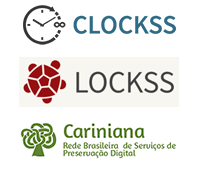Apinayé Indigenous Childhood: reflections on being a child in the village
DOI:
https://doi.org/10.20873/uft.rbec.e15692Abstract
ABSTRACT. This article aims to reflect on socio-historical and cultural aspects of Apinayé childhood, based on a review of two ethnographic research carried out with this people, a TCC in Pedagogy, developed in 2012, and a Master's in Letters research, completed in 2016. We start from the understanding of childhood as a socio-historical construction. Therefore, when reflecting on the Apinayé children, we defend a sensitive and attentive approach to the ways of life of these people. We seek to consider cultural, ethnic, generational, historical and geographic aspects to try to understand this childhood. We emphasize that the Apinayé culture, experienced and practiced by children through rites, traditions and customs, occupies a constitutive dimension of childhood for this people. Furthermore, children not only reproduce what they are taught, but they invent, create and transform what is offered to them through peer culture, as active subjects who play, elaborate and build. The body, the relationship with nature and children's groups are essential to understand the way these children are in the world. More than bringing conclusions about the way of being an indigenous child, we propose reflections on possible childhoods, woven between games, responsibilities and learning in the Apinayé villages.
Downloads
Literaturhinweise
Albuquerque, F. E. (2007). Contribuição da fonologia ao processo de educação indígena Apinayé (Tese de Doutorado). Universidade Federal Fluminense, Niterói.
Almeida, S. A. (2011). A Educação Escolar Apinayé na Perspectiva Bilíngue e Intercultural: Um Estudo Sociolinguístico das Aldeias São José e Mariazinha (Dissertação de Mestrado). Universidade Federal do Tocantins, Araguaína.
Apinagé, C. S. (2017). Escola, meio ambiente e conhecimentos: formas de ensinar e aprender na teoria e na prática entre os Apinajé.
Ariès, P. (2011). História social da criança e da família (2ª ed.). LTC: Rio de Janeiro.
Barbosa, M. C. S. (2007). Culturas escolares, culturas de infância e culturas familiares: As Socializações e a escolarização no entretecer destas culturas. Educ. Soc, 28(100), 1059-1083. https://doi.org/10.1590/S0101-73302007000300020
Cohn, C. (2005). Antropologia da Criança. Rio de Janeiro: Jorge Zahar Ed.
Corsaro, W. A. (2011). Sociologia da Infância (2. ed.). Porto Alegre: Artmed.
Damatta, R. (1976). Um Mundo Dividido: A Estrutura Social dos Índios Apinayé. Petrópolis: Vozes.
Giraldin, O. (2001). Um mundo unificado: cosmologia, vida e morte entre os Apinajé. Campos-Revista de Antropologia, 1, 31-46. https://doi.org/10.5380/cam.v1i0.1567
Grupioni, L. D. B. (2011). Os povos Indígenas e a Escola Diferenciada: Comentários sobre alguns instrumentais jurídicos internacionais. In Grupioni, L. D. B., Vidal, L., & Fishmann, R.. (Orgs.). Povos Indígenas e Tolerância construindo práticas de respeito e solidariedade (s./p.). São Paulo: EDUSP.
Instituto Socioambiental – ISA (s/d). Terras indígenas no Brasil: Terra Indígena Apinayé. Recuperado de: https://terrasindigenas.org.br/pt-br/terras-indigenas/3584#pressoes. Acesso em: 06 ago. 2022.
Krenak, A. (2019). Ideias para adiar o fim do mundo. São Paulo: Companhia das Letras.
Ladeira, M. E., & Azanha, G. (2003). Povos indígenas no Brasil: Apinajés. Instituto Socioambiental. Recuperado de: https://pib.socioambiental.org/pt/Povo:Apinaj%C3%A9. Acesso em: 07 ago. 2022.
Locatelli, R. (2016). Aquisição do Português como Segunda Língua Pelos Alunos Apinayé da Aldeia São José (Dissertação de Mestrado). Universidade Federal do Tocantins, Araguaína.
Locatelli, R. (2012). As crianças indígenas Apinaye e a alfabetização bilíngue: um estudo exploratório na Aldeia São José (Monografia de Graduação). Universidade Federal do Tocantins, Tocantinópolis.
Mandulão, F. S. (2006). Educação na visão do professor indígena. In Grupioni, L. D. B. (Org.). Formação de professores indígenas: repensando trajetórias (s./p.). Brasília: Ministério da Educação, Secretaria de Educação Continuada, Alfabetização e Diversidade.
Munduruku, D. (2018). Escrita indígena: registro, oralidade e literatura: O reencontro da memória. In ___. Dorrico, J., Danner, L. F., Correia, H. H. S., & Danner, F. (Orgs.). Literatura indígena brasileira contemporânea: criação, crítica e recepção (s./p.). Porto Alegre: Editora Fi.
Nimuendajú, C. (1983). Os Apinayé. Belém: Ed. UFPA.
Schaden, E. (1974). Aspectos fundamentais da cultura Guarani. São Paulo: EPU/Edusp.
Silva, A. L., Nunes, A., & Macedo, A. V. L. S. (Org.) (2002). Crianças indígenas: ensaios antropológicos. São Paulo: Global.
Tassinari, A. (2001). Escola indígena: novos horizontes teóricos, novas fronteiras de educação. In Silva, A. L., & Leal, M. K. F. (Orgs.). Antropologia, História e Educação – A questão indígena e a escola (s./p.). São Paulo: Global.
Torres, C. A. A., & Costa, M. O. (2020). Povo indígena Apinajé: ritual da tora grande (párkaper). Articulando e Construindo Saberes, 5. https://doi.org/10.5216/racs.v5i.60382
Veröffentlicht
Zitationsvorschlag
Ausgabe
Rubrik
Lizenz
Copyright (c) 2023 Rosimar Locatelli, Janaina Ribeiro de Rezende

Dieses Werk steht unter der Lizenz Creative Commons Namensnennung 4.0 International.
Creative Commons Attribution License
Creative Commons Attribution License
Proposal for Copyright Notice Creative Commons
1. Policy Proposal to Open Access Journals
Authors who publish with this journal agree to the following terms:
A. Authors retain copyright and grant the journal right of first publication with the work simultaneously licensed under the Creative Commons Attribution License that allows sharing the work with recognition of its initial publication in this journal.
B. Authors are able to take on additional contracts separately, non-exclusive distribution of the version of the paper published in this journal (ex .: publish in institutional repository or as a book), with an acknowledgment of its initial publication in this journal.
C. Authors are permitted and encouraged to post their work online (eg .: in institutional repositories or on their website) at any point before or during the editorial process, as it can lead to productive exchanges, as well as increase the impact and the citation of published work (See the Effect of Open Access).














